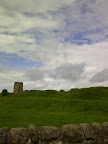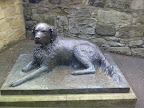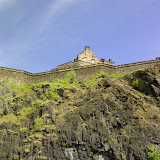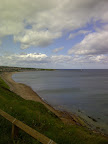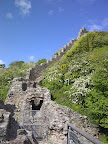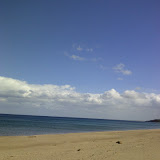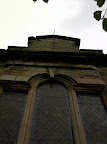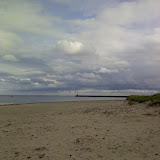“…And he left us matchstalk men and matchstalk cats and dogs He left us kids on the corner of the street that were sparking clogs Now he takes his brush and he waits outside them pearly gates To paint his matchstalk men and matchstalk cats and dogs
Now Lowry’s hang upon the wall Beside the greatest of them all… “
© Brian & Michael 08/04/1978
LS Lowry, an artist who was inspired by the sights and sounds of Berwick Upon Tweed – each and time he had taken a holiday there. We picked LS Lowry trail which we found the previous day… It inevitably led me to humming the song above nearly all day 🙂 . Obviously I found out that Lowry painted a lot more than matchstick men and dogs 🙂 !
Our walk started out in Berwick, although it was from Pudding Lane – which was a little disturbing – since Pudding Lane is also in London where the Great Fire of London is supposed to have started! How confusing is that!?!
We decided to explore across the other side of the river Tweed, which we could see from Berwick Pier. This side of Berwick was not as busy and although we were now walking a seemingly narrow street – this actually known as “Main Street” . A main street not as you would have expected full of shops – it mainly small residential cottages.
It was not long before we discovered LS Lowry had trodden these very streets…. He had used his pencil and imagination to create a set of images about the ordinary life on the Main Street of Berwick. As we wandered down the road, we realised this had once been a very busy quayside had been cleared for redevelopment…. I am unsure if this was a good thing or a bad thing – but there is now a beautiful view across the river Tweed.
Walking along the quayside, it was obvious that this beautiful shore was very inspirational to Lowry and I wouldn’t be surprised to many more. We continued past the Lifeboat Station, which had been in operation in this position since 1834 – although in it’s history it had been relocated at least once.
As we walked along we did notice a huge stone bridge, across the other side of the street which looked very odd, since it was not used for anything and therefore completely unnecessary – an old train branch line perhaps? But we would need proof of course!
We did not continue down the shoreline, as we were unsure if the coast path continued around some old warehouse buildings that we came across. It did not look very inviting, so we decided to walk along “Spittal High Street”? Eventually we found a footpath which led us to Spitall Promenade. I have said this in many blogs before, and I won’t hesitate to mention it again – I wish I had brought my bucket and spade! The Spittal Sands are fantastic – definitely the place for a sandcastle competition and some Punch and Judy on the beach :-).
It seems that Spittal Sands was a very popular Victorian Holiday Destination. It was popular with people from London, Europe and Scotland. The Holiday Camp and Caravan Park that opened in 1945 and 1950 respectively attracted a huge number of tourists to the area making this a very popular resort. Unfortunately, with the closure of the Kelso branch line in 1968 – this was the beginning of the end of this wonderful holiday resort – so the predicted future holiday destination by the Victorian’s was abruptly ended by Dr Beeching 😦 . This resolved our mystery bridge – it was an abandoned branch line after all.
It seems that Lowry spent a lot of time at Spittal sands – not only enjoying the sun, sea and sand – but observing and painting the area too. Clearly, he enjoyed the prom – a couple of his paintings “Girl In a Red Hat on a Promenade”, 1966 and “Man Looking Out to Sea”, 1964 are painted on Spittal Promenade. We decided to depart the seafront to enjoy some cliff walking. It gave us chance to see the view right across Spittal Sands and to Berwick Pier
We were now part of the “Northumberland Coast Path”. The entire path is 64 mile (~ 103 km) long – but we were not going to walk all of it! The direction we were walking was towards Seahouses, where you can pick up the boat to Farne Island – also known as “Holy Island”. I doubt somehow we were going to get that far.
This part of the coast path was quite strange. The Great North Eastern Railway runs alongside the cliff, which does feel quite ominous – I found myself hoping that a high speed train would not come rushing past at any moment. I had noted when I walked along the cliffs towards West Bay how I was not keen on being on windy cliffs – on this occasion we definitely felt like were being blown away! We decided to abandon the cliff top walk for the day, since the wind got the better of both of us, which was a shame, as I would recommend this walk , despite the high speed trains ( shame it wasn’t a lovely old stream train – but then again I am biased!!) We turned back towards Spittal.
We passed Cow Road – although I am not sure why this was so called? Perhaps farmers used it for herding cows? That is logical! However, from a local map in 1828, the Old Berwickhill Colliery was located at the end of this road which does not really indicate farming but mining! As we walked further in, we were confused to find ourselves confronted with a sign saying “Welcome to Berwick Upon Tweed” – we did not even know we had left it! 😀
As we walked through the small high street, it really did seem like it was a lovely little village. I could see why the Victorians would have enjoyed this as a Holiday Resort. In fact, one of the biggest reasons the Victorians enjoyed Spittal so much, was the “Spa Well” that was located in there. The Well itself was built up in the late 18th Century and has been identified on a 1837 map as “Spaw Well”. This was one of the major reasons that in the early Nineteenth Century Spittal developed as a resort. A “New Town” was built up to attract visitors for sea-bathing and to drink the waters from the Well. The spa was valued as a source of iron, lime, magnesia and sulphate of soda.
We left the high street to sit on the prom – and watch gannets dive into the sea for fish. A great sight to see. Gannets have made a home on Bass Rock – North Berwick – and obviously found it that it was worth the flight to Spittal for some great fish!
We continued our walk along the bay and found evidence of Spittal’s fishing industry. All indications seem to me of Salmon fishing – but I have found that the smokehouses and the fishing that was done in Spittal seems to have been herring fishing and not Salmon – unless anyone can correct me?
Passing by the mouth of the Tweed once again, and leaving behind the beautiful Spittal Sands, we crossed the Old Bridge back into Berwick Upon Tweed. We had picked up the Lowry Trail again. We had stumbled across “Bridge End” this was originally hand drawn by Lowry and subsequently committed to canvas in 1938. When I was comparing the painting to the buildings that still survive today – it felt that not much had changed between 1938 and 2011 ! Amazing…
Leaving Lowry behind, we decided to continue our walk along the Tweed River. Amazingly this is still part of the “Northumberland Coast Path” so we never really left it! This walk was to take us under two bridges. One was a road bridge – the other a railway bridge. Why is that significant? The railway bridge is actually quite stunning to behold. It looks quite an engineering feat. The “Royal Border Bridge”, as it’s known, took over 3 years to build, 10,000 man days and over 40,000 bricks to complete!
As we passed beneath the bridge, we had found part of Berwick Castle. One of the most notable things about what is left of the castle are something that looked like stone stairs. These “Breakneck Stairs” as it is known – was a wall built by the English and modified to have holes cut out for artillery men to fire handguns at the enemy!
Sadly there is not much left of the castle since it was mostly demolished due to the building of the railway 😦 which is a shame. The castle has a rich history of fighting between English and Scots – it was first reputably rebuilt by Edward I. The Victorians must have felt the castle was not of use and removed it as the railway was more important!
The path takes an odd turn here and walks along side the castle uphill and no longer along the river Tweed. It brought us out at Berwick Upon Tweed Railway Station. We continued along Northumberland Avenue to find the coast again – a nice way to end a days walk – with an ice cream and a short walk along the coast path and stare out at the clear and beautiful North Sea.
All the photos for the days walk are as follows –
<><
